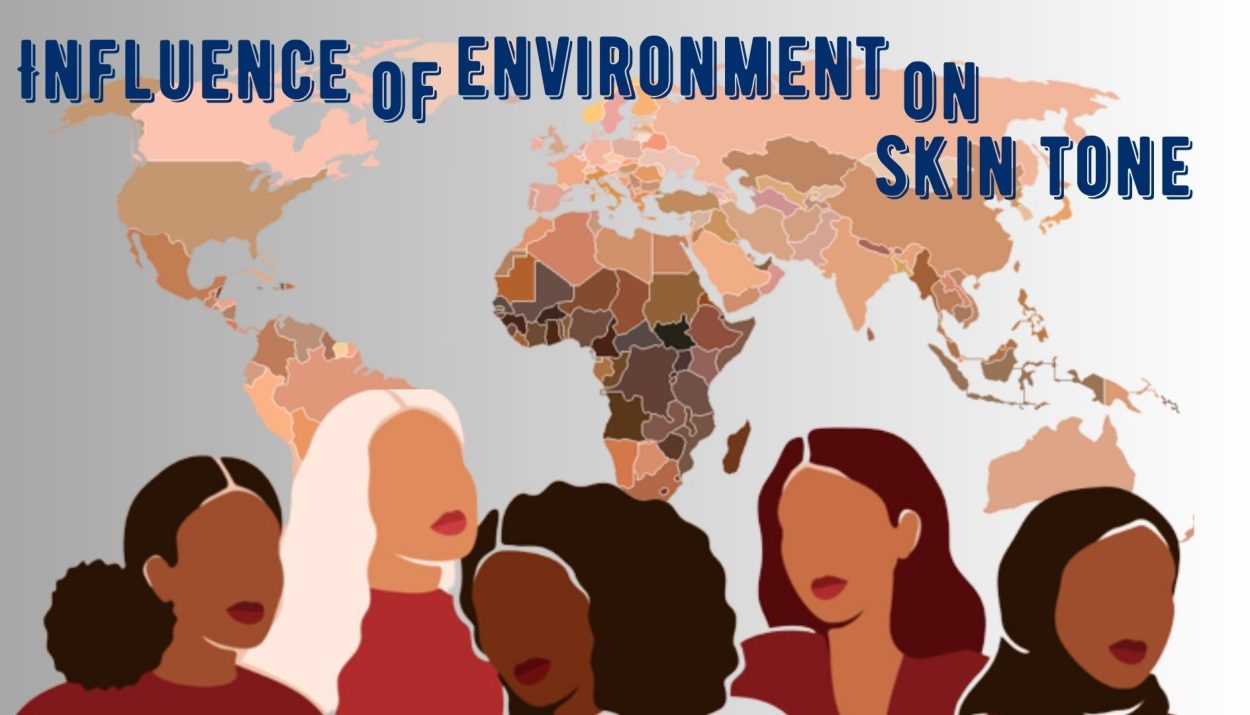Since the earliest days of anthropology, skin colour has been a crucial distinguishing feature. People from various regions around the world exhibit a wide range of skin pigmentation. Notably, individuals from equatorial zones, Melanesia, Australia, southern India, and Africa tend to have darker skin. Skin tone is a remarkable and diverse characteristic among human populations, reflecting both genetic and environmental factors. While genetics play a fundamental role in determining skin colour, anthropologists have long recognized the profound influence of the environment on the evolution and variation of skin tone.
Skin tone is defined as “the colour of the surface of someone’s skin” (Cambridge Dictionary).
The Role of Melanin
Melanin, the definition of which is “any of various black, brown, reddish-brown, reddish-yellow, or yellow pigments of living organisms that in animals are typically produced in melanocytes by the oxidation of tyrosine followed by polymerization and are found especially in skin, hair, feathers, and eyes” (Merriam- Webster Dictionary).
To understand the influence of the environment on skin tone, it is essential to explore the role of melanin, the pigment responsible for skin, hair, and eye colour. It is an insoluble substance found in tiny granules, a highly resistant to chemical changes, making it a key factor in determining skin colour. Melanin is produced by specialized skin cells called melanocytes, found among the basal cells of the epidermis. The quantities of melanocytes in a specific area of the body, varying between approximately 1,000 and over 2,000 per square millimetre, display a consistent similarity across and within various racial groups. Melanin comes in two primary forms: eumelanin and pheomelanin. Eumelanin provides a darker hue to the skin, while pheomelanin contributes to lighter shades.
Natural Selection and Ultraviolet (UV) Radiation
One of the most significant environmental factors shaping skin tone is ultraviolet (UV) radiation from the sun. Skin colour is closely linked to geographical factors, specifically a direct correlation with UV radiation levels. This connection is primarily influenced by sun exposure. UV radiation is more intense near the equator and less so as one moves away from it. Here’s how this factor influences skin tone:
Equatorial Regions: In regions near the equator, where UV radiation is abundant, populations have developed darker skin rich in eumelanin. This adaptation acts as a natural sunscreen, protecting against the harmful effects of excessive UV exposure, such as DNA damage and skin cancer.
Northern Regions: Conversely, populations in northern regions with lower UV radiation levels exhibit lighter skin tones, characterized by a higher presence of pheomelanin. Lighter skin allows for more efficient absorption of limited sunlight, crucial for synthesizing vitamin D, which aids in bone health and mineral absorption.
When a specific level of UV rays permeates the skin, it facilitates the human body’s utilization of vitamin D to aid in the absorption of vital calcium for maintaining strong bones. This intricate equilibrium clarifies why populations migrating to colder regions with reduced sunlight evolved lighter skin tones. As individuals relocated to regions farther from the equator where UV radiation levels were lower, natural selection favoured lighter skin tones, enabling UV rays to penetrate and facilitate the production of essential vitamin D.
Research indicates that the intensity of ultraviolet radiation plays a predominant role in explaining more than 85% of the diversity in skin colour among the world’s indigenous populations. Hence, the overwhelming majority of variations in skin colour can be attributed to natural selection in response to varying levels of ultraviolet radiation.
Migration and Environmental Adaptation
Human migration patterns have played a pivotal role in the development of diverse skin tones. As ancient human populations migrated to different regions of the world, they encountered varying environmental conditions, including sunlight intensity.
Remember that all human beings trace their origins back to Africa without exception, supported by both genetic and fossil evidence. Africa boasts the highest genetic diversity of any region on Earth. The onset of human migrations marked a complex pattern of movement across the Eurasian landmass and beyond. It’s important to note that this movement wasn’t a unidirectional flow; instead, it likely involved multiple migration events and bidirectional movement to and from various regions as humans expanded their presence.
Out-of-Africa Migration: Around 50,000 years ago, as human ancestors migrated out of Africa and into Europe, Asia, and beyond, they faced changes in UV radiation levels. This led to adaptive changes in skin tone over generations, with populations in sunnier regions developing darker skin to protect against UV damage.
Northern Migration: As some of our ancestors ventured further north into areas with reduced sunlight, their skin gradually lightened to optimize vitamin D production. This illustrates the remarkable adaptability of human populations to diverse environments. We are aware that specific wavelengths of ultraviolet radiation are essential for the body’s functions. In the course of evolution, it became evident that the reduction of pigmentation was highly significant.
Conclusion
The influence of the environment on skin tone, as observed through an anthropological lens, is a testament to human adaptability and evolution. Skin colour is not merely a cosmetic trait but a reflection of the complex interplay between genetics and environmental factors, primarily UV radiation. Various skin tones offer distinct advantages in diverse geographical settings. Interestingly, skin colour has proven to be a product of regional adaptations for survival.
Always remember that your skin tone is a product of nature’s selection, tailored for your survival. Embrace and shine brightly, for you possess unique advantages that set you apart from others.
